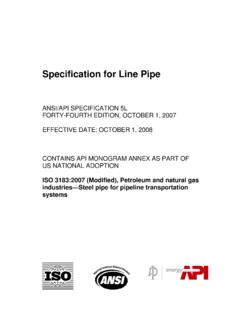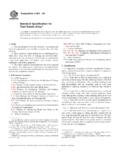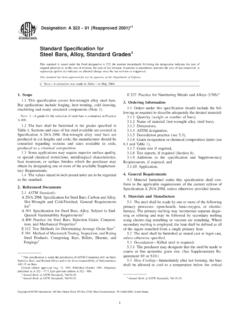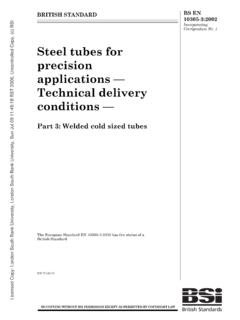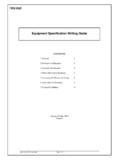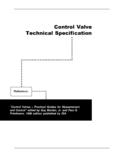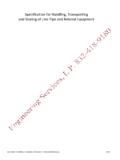Transcription of Specification for Line Pipe - Engineering Steel Supplier
1 Specification for line pipe ANSI/API Specification 5L. FORTY-FOURTH EDITION, OCTOBER 1, 2007. EFFECTIVE DATE: OCTOBER 1, 2008. CONTAINS API MONOGRAM ANNEX AS PART OF. US NATIONAL ADOPTION. ISO 3183:2007 (Modified), Petroleum and natural gas industries Steel pipe for pipeline transportation systems Special Notes API publications necessarily address problems of a general nature. With respect to particular circumstances, local, state, and federal laws and regulations should be reviewed. Neither API nor any of API's employees, subcontractors, consultants, committees, or other assignees make any warranty or representation, either express or implied, with respect to the accuracy, completeness, or usefulness of the information contained herein, or assume any liability or responsibility for any use, or the results of such use, of any information or process disclosed in this publication.
2 Neither API nor any of API's employees, subcontractors, consultants, or other assignees represent that use of this publication would not infringe upon privately owned rights. API publications may be used by anyone desiring to do so. Every effort has been made by the Institute to assure the accuracy and reliability of the data contained in them; however, the Institute makes no representation, warranty, or guarantee in connection with this publication and hereby expressly disclaims any liability or responsibility for loss or damage resulting from its use or for the violation of any authorities having jurisdiction with which this publication may conflict. API publications are published to facilitate the broad availability of proven, sound Engineering and operating practices. These publications are not intended to obviate the need for applying sound Engineering judgment regarding when and where these publications should be utilized.
3 The formulation and publication of API publications is not intended in any way to inhibit anyone from using any other practices. Any manufacturer marking equipment or materials in conformance with the marking requirements of an API standard is solely responsible for complying with all the applicable requirements of that standard. API does not represent, warrant, or guarantee that such products do in fact conform to the applicable API standard. All rights reserved. No part of this work may be reproduced, stored in a retrieval system, or transmitted by any means, electronic, mechanical, photocopying, recording, or otherwise, without prior written permission from the publisher. Contact the Publisher, API Publishing Services, 1220 L. Street, , Washington, 20005. Copyright 2007 American Petroleum Institute API Specification 5L/ISO 3183. API Foreword This standard shall become effective on the date printed on the cover but may be used voluntarily from the date of distribution.
4 Standards referenced herein may be replaced by other international or national standards that can be shown to meet or exceed the requirements of the referenced standard. This American National Standard is under the jurisdiction of the API Subcommittee 5 on Tubular Goods. ISO 3183 was prepared by Technical Committee ISO/TC 67, Materials, equipment and offshore structures for petroleum, petrochemical and natural gas industries, SC2, Pipeline transportation systems. In this American National Standard, certain technical modifications have been made. These technical modifications from the ISO Standard have not been incorporated directly into this API. (US) national adoption. The normative modifications have been noted with an arrow ( Annex N ). adjacent to the clause, table, figure, etc. that has been modified. A complete list of modifications can be found in the normative Annex N.
5 Nothing contained in any API publication is to be construed as granting any right, by implication or otherwise, for the manufacture, sale, or use of any method, apparatus, or product covered by letters patent. Neither should anything contained in the publication be construed as insuring anyone against liability for infringement of letters patent. This document was produced under API standardization procedures that ensure appropriate notification and participation in the developmental process and is designated as an API. standard. Questions concerning the interpretation of the content of this publication or comments and questions concerning the procedures under which this publication was developed should be directed in writing to the Director of Standards, American Petroleum Institute, 1220 L Street, , Washington, 20005. Requests for permission to reproduce or translate all or any part of the material published herein should also be addressed to the director.
6 Generally, API standards are reviewed and revised, reaffirmed, or withdrawn at least every five years. A one-time extension of up to two years may be added to this review cycle. Status of the publication can be ascertained from the API Standards Department, telephone (202) 682-8000. A catalog of API publications and materials is published annually and updated quarterly by API, 1220 L Street, , Washington, 20005. Suggested revisions are invited and should be submitted to the Standards and Publications Department, API, 1220 L Street, NW, Washington, DC 20005, ii Contents Page API Foreword .. ii Foreword .. v Introduction .. vi 1 Scope .. 1. 2 Conformity .. 1. Units of measurement .. 1. Rounding .. 1. Compliance to this International Standard .. 1. 3 Normative references ..2. 4 Terms and definitions .. 5. 5 Symbols and abbreviated terms .. 10. Symbols ..10.
7 Abbreviated terms .. 12. 6 pipe grade, Steel name and delivery condition .. 13. pipe grade and Steel name .. 13. Delivery condition .. 13. 7 Information to be supplied by the purchaser .. 15. General information .. 15. Additional information .. 15. 8 Manufacturing .. 18. Process of 18. Processes requiring validation .. 20. Starting material .. 20. Tack welds .. 20. Weld seams in COW pipe .. 21. Weld seams in SAW pipe .. 21. Weld seams in double-seam pipe ..21. Treatment of weld seams in EW and LW pipes .. 21. Cold sizing and cold expansion .. 21. Strip/plate end welds .. 22. Jointers .. 22. Heat treatment .. 22. Traceability .. 22. 9 Acceptance criteria .. 22. General .. 22. Chemical composition .. 23. Tensile properties ..27. Hydrostatic test .. 29. Bend test .. 29. Flattening test .. 29. Guided-bend test .. 30. CVN impact test for PSL 2 pipe .. 30. DWT test for PSL 2 welded pipe .
8 31. Surface conditions, imperfections and defects .. 32. Dimensions, mass and tolerances .. 33. Finish of pipe ends .. 38. Tolerances for the weld seam .. 40. Tolerances for mass .. 43. Weldability of PSL 2 pipe .. 43. 10 Inspection .. 44. Types of inspection and inspection documents .. 44. Specific inspection .. 45. 11 Marking .. 67. General .. 67. pipe markings .. 67. Coupling markings .. 69. 12 Coatings and thread protectors .. 69. Coatings and linings .. 69. Thread protectors .. 70. 13 Retention of records .. 70. 14 pipe loading .. 71. Annex A (normative) Specification for welded jointers .. 72. Annex B (normative) Manufacturing procedure qualification for PSL 2 pipe .. 73. Annex C (normative) Treatment of surface imperfections and defects .. 75. Annex D (normative) Repair welding procedure .. 76. Annex E (normative) Non-destructive inspection for other than sour service or offshore service.
9 82. Annex F (normative) Requirements for couplings (PSL 1 only) .. 94. Annex G (normative) PSL 2 pipe with resistance to ductile fracture propagation .. 97. Annex H (normative) PSL 2 pipe ordered for sour service .. 104. Annex I (normative) pipe ordered as Through the Flowline (TFL) pipe .. 116. Annex J (normative) PSL 2 pipe ordered for offshore service .. 118. Annex K (normative) Non-destructive inspection for pipe ordered for sour service and/or offshore service .. 133. Annex L (informative) Steel designations .. 138. Annex M (informative) Correspondence of terminology between ISO 3183 and its source documents .. 141. Annex N (normative) Identification/Explanation of Deviations ..142. Annex O (informative) API Monogram ..149. Bibliography .. 152. ISO 3183:2007(E). API Specification 5L/ISO 3183. Foreword ISO (the International Organization for Standardization) is a worldwide federation of national standards bodies (ISO member bodies).
10 The work of preparing International Standards is normally carried out through ISO. technical committees. Each member body interested in a subject for which a technical committee has been established has the right to be represented on that committee. International organizations, governmental and non-governmental, in liaison with ISO, also take part in the work. ISO collaborates closely with the International Electrotechnical Commission (IEC) on all matters of electrotechnical standardization. International Standards are drafted in accordance with the rules given in the ISO/IEC Directives, Part 2. The main task of technical committees is to prepare International Standards. Draft International Standards adopted by the technical committees are circulated to the member bodies for voting. Publication as an International Standard requires approval by at least 75 % of the member bodies casting a vote.
